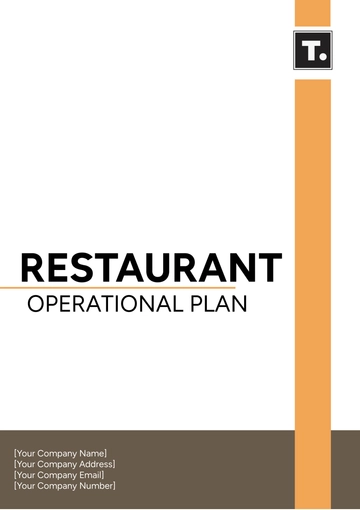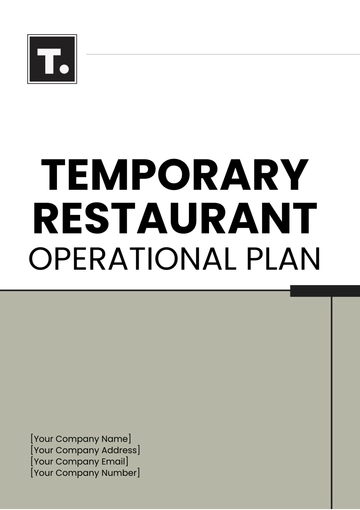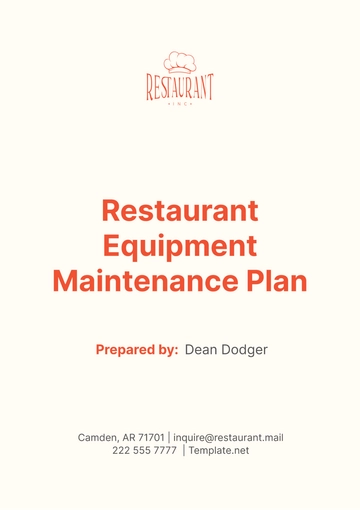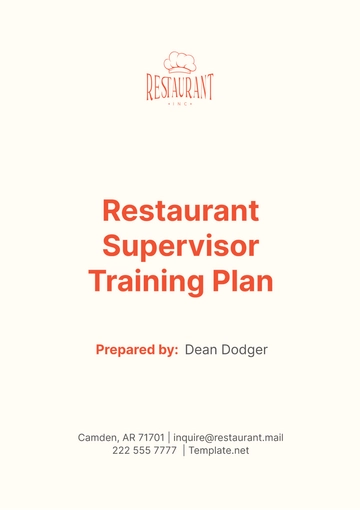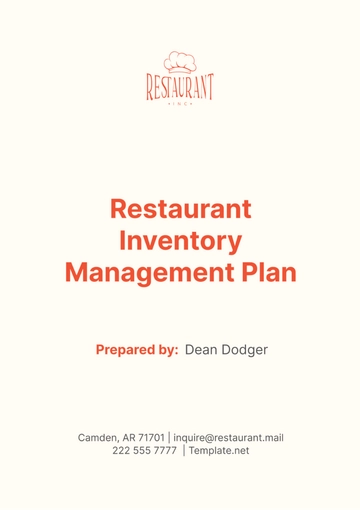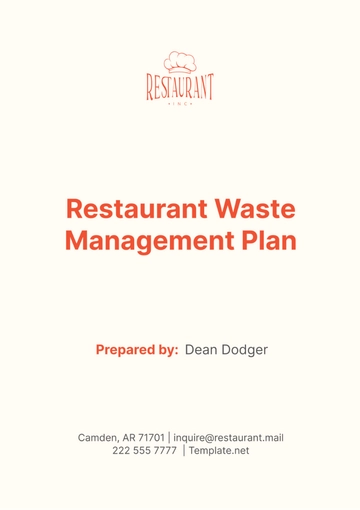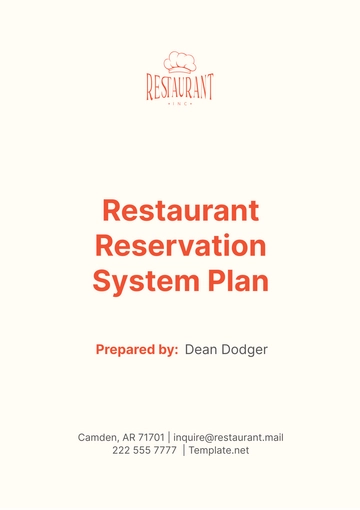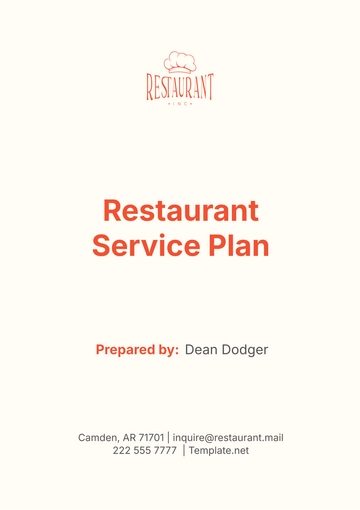Free Restaurant Sustainability Plan
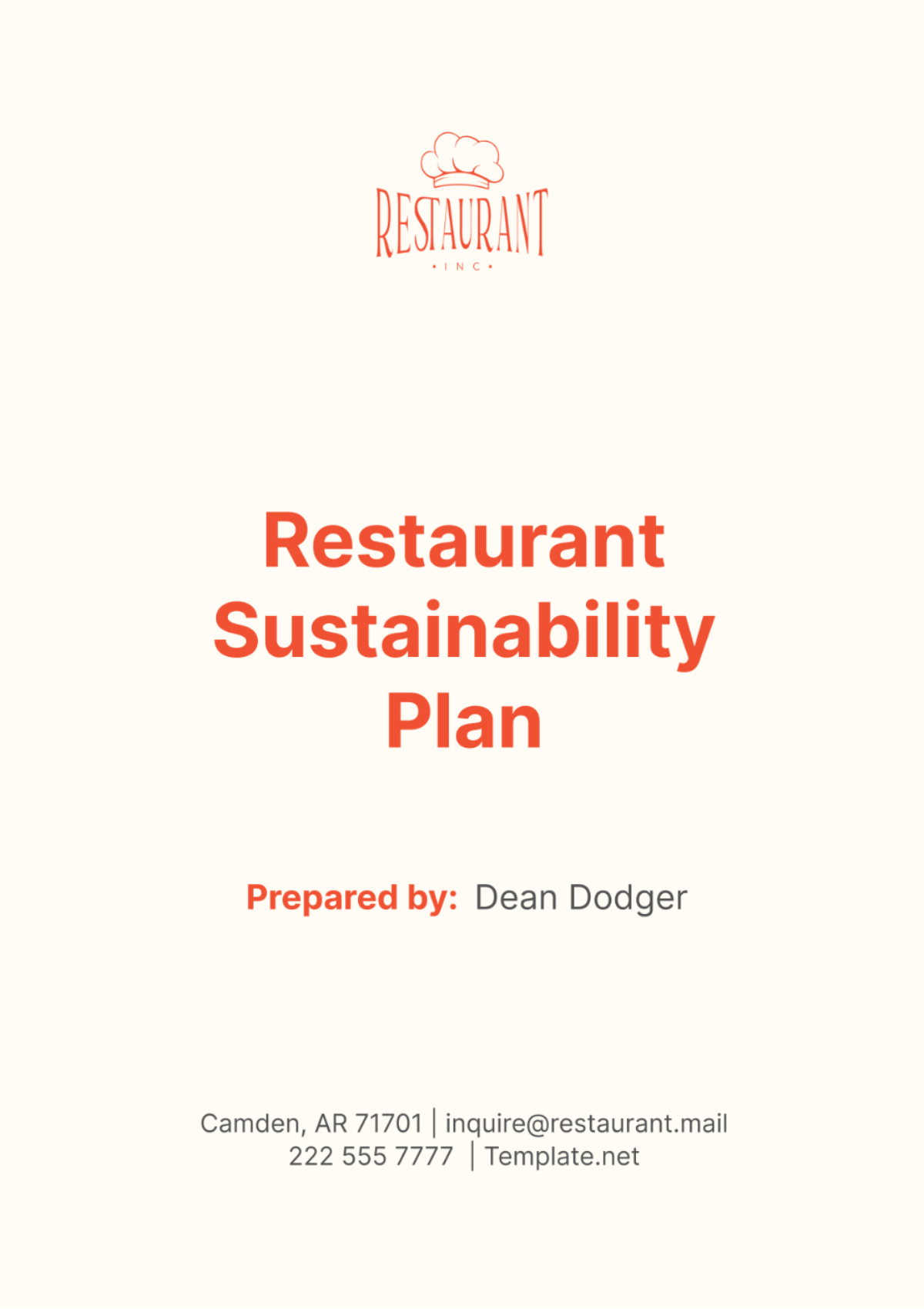
I. Introduction
A. Purpose of the Sustainability Plan
The purpose of our Restaurant Sustainability Plan is to outline our commitment to operating in an environmentally responsible and socially sustainable manner. By implementing sustainable practices throughout our operations, we aim to minimize our environmental footprint, support local communities, and promote long-term ecological balance.
B. Vision and Mission Statement
Vision: To be a leader in sustainable dining, inspiring positive change in the restaurant industry and our community.
Mission: We are dedicated to sourcing local, organic ingredients, reducing waste, conserving resources, and engaging with our staff and customers to foster a culture of sustainability.
C. Overview of Sustainability Goals
Our sustainability goals include:
Reduce waste generation by 50% within the next two years.
Decrease energy consumption by 20% through the implementation of energy-efficient practices and equipment.
Source at least 80% of our ingredients locally and organically.
Achieve zero waste to landfill by implementing comprehensive recycling and composting programs.
Engage with our community through educational workshops and partnerships with local organizations.
II. Baseline Assessment
A. Current Environmental Impact
Energy Usage: Our restaurant currently consumes an average of 10,000 kWh of energy per month, primarily from cooking equipment, refrigeration, and lighting.
Water Consumption: We use approximately 50,000 gallons of water per month for cooking, cleaning, and sanitation purposes.
Waste Generation: On average, we produce 2 tons of waste per month, including food waste, packaging materials, and kitchen scraps.
Carbon Footprint: Based on our energy and resource consumption, our estimated carbon footprint is 200 metric tons of CO2 per year.
B. Resource Inventory
Supply Chain Analysis: We have identified key suppliers for our ingredients, packaging materials, and cleaning products.
Existing Equipment and Infrastructure: Our kitchen is equipped with standard appliances and fixtures, some of which may require upgrades for improved energy efficiency.
C. Stakeholder Analysis
Staff: Our team consists of 20 full-time and part-time employees who are eager to participate in sustainability initiatives.
Customers: We have a diverse customer base that includes local residents, tourists, and corporate clients.
Suppliers: We work with several local farmers and distributors to source our ingredients and supplies.
III. Waste Reduction and Management
A. Recycling Programs
Materials to be Recycled: We plan to implement a comprehensive recycling program to recycle materials such as glass, plastic, paper, and metal. This will involve sorting and separating recyclable materials at designated collection points within the restaurant.
Partnership with Recycling Services: We will establish partnerships with local recycling services to ensure that collected materials are properly processed and recycled according to environmental standards.
B. Composting Initiatives
Organic Waste Composting: To address food waste, we will implement an organic waste composting program. Kitchen scraps, food trimmings, and other organic waste will be collected and composted either on-site or through partnerships with local composting facilities.
On-Site vs. Off-Site Composting: We will evaluate the feasibility of on-site composting using compost bins or partnering with local composting facilities for off-site composting. Factors such as space availability, odor control, and regulatory requirements will be considered in the decision-making process.
C. Food Waste Minimization
Inventory Management: We will implement improved inventory management practices to minimize over-purchasing and reduce food waste. This includes tracking inventory levels, rotating stock, and optimizing ordering quantities based on demand.
Portion Control: Staff will be trained to serve appropriate portion sizes to customers to reduce plate waste. Menu engineering will also be employed to offer flexible portion sizes and encourage customers to order only what they can consume.
Donation Programs: Surplus food that is still safe for consumption will be donated to local food banks or shelters. We will establish partnerships with charitable organizations to ensure that excess food is distributed to those in need.
IV. Energy Efficiency
A. Energy-Efficient Appliances and Equipment
Evaluation of Current Appliances: We will conduct an audit of existing kitchen appliances and equipment to identify energy-intensive items that may need replacement or upgrades. This includes refrigerators, ovens, stoves, and dishwashers.
Plan for Upgrading to Energy-Efficient Models: Based on the audit findings, we will develop a phased plan to replace outdated appliances with energy-efficient models. Priority will be given to equipment with the highest energy consumption and the greatest potential for energy savings.
B. Renewable Energy Integration
Solar Panels: We will explore the installation of solar panels on the restaurant's rooftop or surrounding property to harness solar energy for electricity generation. This will reduce our reliance on grid electricity and lower our carbon footprint.
Wind Energy: Depending on feasibility and local regulations, we will also consider integrating wind energy technology, such as small-scale wind turbines, to supplement our renewable energy sources.
C. Energy Conservation Practices
Staff Training on Energy Conservation: We will provide comprehensive training to staff members on energy-saving practices, such as turning off lights and equipment when not in use, adjusting thermostat settings, and optimizing kitchen workflows to minimize energy consumption.
Smart Energy Management Systems: Investing in smart energy management systems will enable us to monitor and control energy usage more effectively. This may include programmable thermostats, motion-sensing lighting, and energy monitoring software to identify areas for improvement.
V. Water Conservation
A. Low-Flow Fixtures and Equipment
Installation of Low-Flow Faucets and Toilets: We will replace existing faucets and toilets with low-flow models to reduce water consumption. This will involve retrofitting fixtures with aerators and installing dual-flush toilets to minimize water usage without compromising functionality.
Efficient Dishwashing Equipment: Upgrading to energy-efficient dishwashing equipment with water-saving features, such as high-efficiency spray nozzles and water-recycling systems, will further reduce water consumption in our kitchen operations.
B. Water Recycling Systems
Greywater Systems: Implementing greywater recycling systems will allow us to capture and treat wastewater from sinks and dishwashers for reuse in non-potable applications, such as irrigation or flushing toilets.
Rainwater Harvesting: Installing rainwater harvesting systems will enable us to collect rainwater from roof runoff for irrigation purposes, reducing our reliance on municipal water sources during dry periods.
C. Water Usage Monitoring
Regular Audits: We will conduct regular audits of water usage to identify areas of inefficiency and opportunities for improvement. This includes tracking water consumption trends, identifying leaks, and implementing corrective actions to minimize water waste.
Leak Detection Systems: Implementing leak detection systems and conducting routine maintenance checks will help us promptly identify and repair leaks in plumbing fixtures and irrigation systems, preventing water loss and minimizing water-related damage.
VI. Sustainable Sourcing
A. Local and Organic Ingredients
Partnerships with Local Farmers: We will establish direct relationships with local farmers and producers to source seasonal, fresh ingredients grown or raised within our region. This supports local agriculture, reduces transportation emissions, and ensures ingredient freshness and quality.
Sourcing Organic Produce and Meats: Prioritizing organic produce and sustainably raised meats ensures that our ingredients are free from synthetic pesticides, hormones, and antibiotics. This aligns with our commitment to environmental stewardship and promoting animal welfare.
B. Ethical and Fair Trade Products
Fair Trade Coffee, Tea, and Chocolate: We will source fair trade-certified coffee, tea, and chocolate products to support sustainable livelihoods for farmers and producers in developing countries. This ensures fair wages, safe working conditions, and environmental stewardship within the supply chain.
Seafood from Sustainable Fisheries: We are committed to sourcing seafood from sustainable fisheries certified by organizations such as the Marine Stewardship Council (MSC) or the Aquaculture Stewardship Council (ASC). This promotes responsible fishing practices and helps preserve marine ecosystems for future generations.
C. Seasonal Menu Planning
Using Seasonal Produce: Our menu will feature seasonal dishes that showcase locally available produce, reflecting the natural rhythm of the seasons and reducing the carbon footprint associated with long-distance transportation.
Reducing Transportation Footprint: By prioritizing local and seasonal ingredients, we minimize the environmental impact of transportation and support regional food systems, promoting economic resilience and community vitality.
VII. Eco-Friendly Packaging
A. Biodegradable and Compostable Packaging
Selecting Environmentally Friendly Materials: We will transition to biodegradable and compostable packaging materials, such as paper-based products, plant-based plastics (PLA), and compostable food containers, to reduce our reliance on single-use plastics and minimize waste sent to landfills.
Partnering with Suppliers: Working with suppliers who offer eco-friendly packaging options ensures that our packaging materials meet sustainability standards and align with our commitment to environmental responsibility.
B. Reducing Single-Use Plastics
Eliminating Plastic Straws and Utensils: We will phase out the use of plastic straws and utensils in favor of compostable alternatives or reusable options. This reduces plastic pollution in our oceans and protects marine wildlife from harm.
Promoting Reusable Containers for Takeout: Encouraging customers to bring their own reusable containers for takeout orders helps reduce packaging waste and encourages sustainable consumer behavior. We will offer incentives such as discounts or loyalty rewards to incentivize reusable container usage.
VIII. Community Engagement and Education
A. Supporting Local Community Initiatives
Sponsoring Local Events: We will sponsor and participate in community events, festivals, and fundraisers to support local organizations and initiatives aligned with our sustainability values. This fosters community connections and demonstrates our commitment to social responsibility.
Collaborating with Community Organizations: Partnering with local environmental groups, schools, and non-profit organizations allows us to collaborate on sustainability projects, educational workshops, and community outreach programs. This strengthens community ties and amplifies our impact on environmental and social issues.
B. Customer Education Programs
Informational Signage and Materials: We will provide educational materials, such as signage, brochures, and website content, to inform customers about our sustainability initiatives, menu sourcing practices, and ways they can support environmental conservation efforts.
Workshops and Events: Hosting sustainability-themed workshops, cooking classes, and tasting events engages customers in meaningful dialogue about sustainable food choices, environmental stewardship, and local food systems. This empowers customers to make informed decisions and take action towards a more sustainable future.
C. Staff Involvement and Training
Regular Sustainability Training: We will provide ongoing training and education opportunities for staff members to increase awareness of sustainability issues, reinforce best practices, and empower them to champion sustainability initiatives within the workplace and community.
Encouraging Staff Participation in Sustainability Projects: Engaging staff in sustainability projects, such as waste reduction initiatives, community clean-up events, and volunteer opportunities, fosters a sense of ownership and pride in our collective efforts to make a positive impact on the environment and society.
IX. Monitoring and Reporting
A. Setting Measurable Goals and Metrics
Short-Term and Long-Term Goals: We will establish clear, measurable goals for each aspect of our sustainability plan, including waste reduction, energy efficiency, sustainable sourcing, and community engagement. These goals will be aligned with our overall sustainability vision and mission, with targets set for both short-term achievements and long-term outcomes.
Key Performance Indicators (KPIs): To track our progress towards sustainability goals, we will define key performance indicators (KPIs) and metrics to measure our environmental impact, resource usage, and community engagement efforts. These KPIs will include metrics such as waste diversion rates, energy consumption per square foot, percentage of local and organic ingredients sourced, and customer satisfaction ratings.
B. Regular Sustainability Audits
Internal Audits: We will conduct regular internal audits and assessments of our sustainability practices and performance to identify strengths, weaknesses, and areas for improvement. These audits will involve reviewing data, conducting site inspections, and gathering feedback from staff and stakeholders.
Third-Party Audits: In addition to internal audits, we may engage third-party auditors or sustainability consultants to provide independent assessments of our sustainability initiatives and verify our compliance with industry standards, certifications, and best practices. External audits provide valuable insights and credibility to our sustainability efforts.
C. Transparency and Reporting
Annual Sustainability Reports: We are committed to transparency and accountability in our sustainability efforts. We will prepare annual sustainability reports to document our progress towards achieving sustainability goals, highlight achievements, and communicate challenges and lessons learned. These reports will be made available to stakeholders, including customers, employees, investors, and community partners.
Sharing Progress with Stakeholders: Beyond formal reporting, we will actively engage with stakeholders to share updates and progress on our sustainability journey through various channels, including social media, newsletters, website updates, and community events. By fostering open communication and dialogue, we aim to inspire broader awareness and participation in sustainability efforts.
X. Continuous Improvement
A. Feedback Mechanisms
Staff Feedback: We will encourage feedback from staff members on sustainability initiatives, operational processes, and opportunities for improvement. Regular staff meetings, suggestion boxes, and anonymous surveys will be used to solicit input and ideas from employees at all levels of the organization.
Customer Feedback: We value input from our customers and will actively seek feedback on their experiences, preferences, and expectations related to sustainability practices and initiatives. Customer feedback mechanisms, such as comment cards, online surveys, and social media platforms, will be utilized to gather insights and suggestions for enhancing sustainability efforts.
B. Reviewing and Updating the Plan
Regular Review Sessions: We will schedule regular review sessions to evaluate the effectiveness of our sustainability plan, assess progress towards goals, and identify areas for refinement or adjustment. These review sessions will involve key stakeholders and incorporate feedback from audits, assessments, and stakeholder engagement activities.
Adapting to New Sustainability Trends and Technologies: We recognize that sustainability is an evolving field, and we remain committed to staying informed about emerging trends, technologies, and best practices. We will continuously monitor industry developments and innovation opportunities to enhance our sustainability efforts and maintain our leadership position in sustainable dining.
C. Celebrating Successes
Recognizing Achievements: We will celebrate and recognize achievements and milestones reached in our sustainability journey, whether it's meeting waste reduction targets, achieving energy efficiency gains, or fostering meaningful community partnerships. Recognition programs, staff awards, and public acknowledgments will be used to celebrate successes and motivate continued engagement.
Reward Programs for Staff and Community: To incentivize and reward sustainability efforts, we may implement reward programs for staff members who demonstrate exceptional commitment to sustainability practices. Similarly, we may offer incentives or discounts to customers who actively support and participate in our sustainability initiatives, creating a culture of shared responsibility and mutual benefit.
- 100% Customizable, free editor
- Access 1 Million+ Templates, photo’s & graphics
- Download or share as a template
- Click and replace photos, graphics, text, backgrounds
- Resize, crop, AI write & more
- Access advanced editor
Improve your restaurant's environmental impact with the Restaurant Sustainability Plan Template from Template.net. This editable and customizable template provides a comprehensive framework for implementing eco-friendly practices. With the AI Editor Tool, effortlessly tailor the plan to your restaurant's unique needs. Reduce waste, conserve resources, and engage your community with this essential tool for sustainable dining.
You may also like
- Finance Plan
- Construction Plan
- Sales Plan
- Development Plan
- Career Plan
- Budget Plan
- HR Plan
- Education Plan
- Transition Plan
- Work Plan
- Training Plan
- Communication Plan
- Operation Plan
- Health And Safety Plan
- Strategy Plan
- Professional Development Plan
- Advertising Plan
- Risk Management Plan
- Restaurant Plan
- School Plan
- Nursing Home Patient Care Plan
- Nursing Care Plan
- Plan Event
- Startup Plan
- Social Media Plan
- Staffing Plan
- Annual Plan
- Content Plan
- Payment Plan
- Implementation Plan
- Hotel Plan
- Workout Plan
- Accounting Plan
- Campaign Plan
- Essay Plan
- 30 60 90 Day Plan
- Research Plan
- Recruitment Plan
- 90 Day Plan
- Quarterly Plan
- Emergency Plan
- 5 Year Plan
- Gym Plan
- Personal Plan
- IT and Software Plan
- Treatment Plan
- Real Estate Plan
- Law Firm Plan
- Healthcare Plan
- Improvement Plan
- Media Plan
- 5 Year Business Plan
- Learning Plan
- Marketing Campaign Plan
- Travel Agency Plan
- Cleaning Services Plan
- Interior Design Plan
- Performance Plan
- PR Plan
- Birth Plan
- Life Plan
- SEO Plan
- Disaster Recovery Plan
- Continuity Plan
- Launch Plan
- Legal Plan
- Behavior Plan
- Performance Improvement Plan
- Salon Plan
- Security Plan
- Security Management Plan
- Employee Development Plan
- Quality Plan
- Service Improvement Plan
- Growth Plan
- Incident Response Plan
- Basketball Plan
- Emergency Action Plan
- Product Launch Plan
- Spa Plan
- Employee Training Plan
- Data Analysis Plan
- Employee Action Plan
- Territory Plan
- Audit Plan
- Classroom Plan
- Activity Plan
- Parenting Plan
- Care Plan
- Project Execution Plan
- Exercise Plan
- Internship Plan
- Software Development Plan
- Continuous Improvement Plan
- Leave Plan
- 90 Day Sales Plan
- Advertising Agency Plan
- Employee Transition Plan
- Smart Action Plan
- Workplace Safety Plan
- Behavior Change Plan
- Contingency Plan
- Continuity of Operations Plan
- Health Plan
- Quality Control Plan
- Self Plan
- Sports Development Plan
- Change Management Plan
- Ecommerce Plan
- Personal Financial Plan
- Process Improvement Plan
- 30-60-90 Day Sales Plan
- Crisis Management Plan
- Engagement Plan
- Execution Plan
- Pandemic Plan
- Quality Assurance Plan
- Service Continuity Plan
- Agile Project Plan
- Fundraising Plan
- Job Transition Plan
- Asset Maintenance Plan
- Maintenance Plan
- Software Test Plan
- Staff Training and Development Plan
- 3 Year Plan
- Brand Activation Plan
- Release Plan
- Resource Plan
- Risk Mitigation Plan
- Teacher Plan
- 30 60 90 Day Plan for New Manager
- Food Safety Plan
- Food Truck Plan
- Hiring Plan
- Quality Management Plan
- Wellness Plan
- Behavior Intervention Plan
- Bonus Plan
- Investment Plan
- Maternity Leave Plan
- Pandemic Response Plan
- Succession Planning
- Coaching Plan
- Configuration Management Plan
- Remote Work Plan
- Self Care Plan
- Teaching Plan
- 100-Day Plan
- HACCP Plan
- Student Plan
- Sustainability Plan
- 30 60 90 Day Plan for Interview
- Access Plan
- Site Specific Safety Plan


